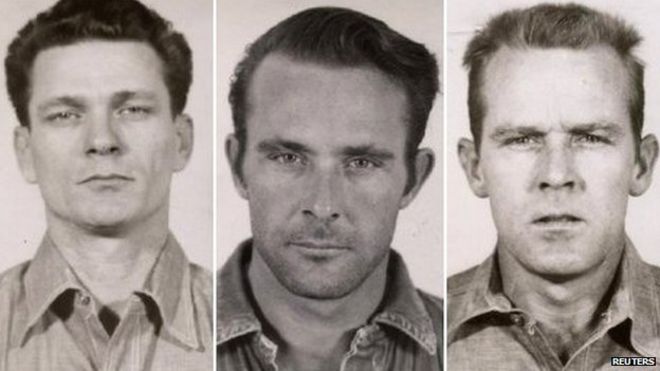The so-called inescapable prison of Alcatraz was crumbling and in 1962 three inmates made use of the deteriorating buildings to carry out a daring escape, fleeing from Alcatraz Island and into the waters of San Francisco Bay. The dramatic escape was dramatized in the now classic 1969 film “Escape From Alcatraz” starring Clint Eastwood in the leading role of Frank Morris. Never seen or heard of again, many believe they died in those waters desperately trying to make to the mainland. All three have officially been declared dead by drowning, but rumors are they did make it and they escaped into the crowds of the city, created new identities and lived their lives as free men.

Today, scientists have used computer technology to simulate the exact tides and conditions of that night and have concluded that if they left at the right time, they may have made it alive.
Frank Morris, John Anglin and Clarence Anglin
On 11 June 1962 three prisoners, Frank Morris and brothers, John and Clarence Anglin achieved the impossible; they successfully broke out of Alcatraz Federal Penitentiary in what is now known as the most famous Alcatraz escape in history.
These were three intelligent men, lifelong criminals with dozens of escape attempts between them across other prisons. It was not a surprise they would attempt an Alcatraz escape. Realizing the prison was old and the walls were beginning to rot, they decided they were going to tunnel their way out.
They discovered the ventilation shaft above B block hadn’t been sealed and blocked off with concrete like all the others. If they could get into it, they knew they could get to the roof. To get there, however, they had to get out of their cells.
Alcatraz Penitentiary sits on Alcatraz Island just off the coast of San Francisco. Originally the location for a military fort and later a military prison, the island is surrounded by deep rough waters only accessible by boat.
Taken on by the Federal Bureau of Prisons in 1933, Alcatraz was developed to manage the ongoing crime problems of the 1930’s with gangs taking over the cities. More security, new guard towers and solid fencing were installed to become one of the toughest prisons in American history.
No one wanted to be sent to Alcatraz, it had a feared reputation and the conditions were brutal. Trying to escape was futile. If you managed to get past the prison walls you were met with water and lots of it. There was nowhere to go and nowhere to run. Furthermore, one guard for every three prisoners and a 200-meter perimeter fence around the prison walls made any attempts at escape almost impossible.
A number of escape attempts however were made, with most being killed in the process. The 1946 Battle of Alcatraz made history with rioting for two days from prisoners who had taken over the prison, killing officers and other inmates. For ten years no other prisoners attempted to escape from Alcatraz with the memory and impact of those two days running deep.
How Did They Escape?
Each cell had a simple metal grate for ventilation. Behind the grate was a narrow corridor that went directly to an open duct to the roof. Frank Morris and the Anglin brothers set about planning how they could tunnel through behind the grate. Other inmates gave them utensils from the kitchen and workshops which they used to craft the tools they needed to dig.
They created a drill from spare parts; they sharpened spoons to chip away at the concrete walls. Day after day, month after month when the lights went out in Block B, they quietly carried on digging through the night. It took them nine months to complete their tunnels, each leading from their cells through the ventilation shaft and out onto the roof of the prison.
They made replicas of steel grates from cardboard and tobacco boxes, knowing they needed to keep their cells looking as normal as possible. During the day they planned the next stage of their escape; how to get off Alcatraz Island.
They knew the waters were their biggest barrier and they knew this was what had foiled many escape attempts in the past. Again using supplies from the kitchen, laundry and workshops and aided by fellow prisoners, they created a raft and life jackets from raincoats.
Over 50 raincoats were used and they had a squeeze box to inflate the raft. There was no way to test it so they just had trust it was going to be good enough to get them across the Bay. They built paddles for moving through the water from tools they managed to get hold of. This was a well-planned and carefully crafted escape plan and these were men determined to make it out alive.
Using wire frames, plaster, soap and real hair, they made fake heads from paper mache. One of Anglin brothers worked in the barbers so the hair was easily available to them. Their idea was to put the heads in their beds to make sure guards doing head counts would not realize they were missing. This would give them the time they needed to get down to the water’s edge, inflate the raft and start rowing across the water and to freedom.
On the night of 11 June 1962, they put their plan into action. It was a normal day in Alcatraz prison; the guards did their rounds, checking the cells and doing their head-count. They had no idea of the events that were due to unfold that evening.
After lights out, Frank Morris, Clarence and John Anglin put their fake heads on their pillows, drew the duvets up and created a body shape. Satisfied it looked realistic; at 9pm they escaped through their tunnels.
Other prisoners could hear them crawling behind the walls. The guards saw nothing amiss and carried on past the three men’s cells oblivious. The men made it to the roof causing swarms of seagulls to squawk at their unexpected presence but drew no reaction from the prison guards. They made it down onto the rocks below.
On the morning of June 1962, three men didn’t come out of their cells. Upon head-count men normally are up and at the doors. Alarms were sounded and the hunt began. Word began to get out of this ingenious escape from the inescapable prison that was Alcatraz.
The FBI, police, and army all hunted the coastline and the waters knowing this was their only route out but no trace of them were found. Their cells showed how they had escaped to the horror of the guards and those in charge. When questioned, other inmates began to give some information on this daring escape, the planning and how they had done it.
Originally there as another inmate, Alan West, who was supposed to go with them. He knew about the plan but he couldn’t break through his cell in time to join the other three. He told the FBI what the plan was; that they had planned to go to Angel Island first and then onto the mainland to steal a car.
The FBI swarmed Angel Island and found only a paddle, two lifejackets and a small rubber packet containing photographs and notes. Reports at the time said the makeshift raft was never found and there were no reports of cars stolen in the area.
On 17 July 1962, the crew of a Norwegian cargo ship leaving San Francisco Bay spotted a body with clothing matching the uniform worn by Alcatraz prisoners. Although the body was never retrieved, many felt this proved the three men had failed and drowned in the water.
The Ongoing Hunt for Escapees
The Alcatraz escape was an embarrassment to the prison authorities. This was Alcatraz Penitentiary, the most secure prison available and it had lost three of its prisoners.
The use of the crumbling walls highlighted the deterioration of the prison buildings and the costs involved in maintaining its operation. One year after the escape in 1963, Alcatraz Penitentiary was closed and all prisoners were transferred to other prisons.
This is a story which had intrigued many over the years. No trace of Frank Morris, John Anglin and Clarence Anglin had ever been found, leading some to believe they were still alive. In 1979 the FBI passed the case to US Marshalls. Known for hunting down escaped prisoners, the chance that the three men were still alive and living free somewhere was a chance they could not take.
At that time all reports and documentation relating to the escape were still on paper and the US Marshalls digitized them over two years of gathering all the files together. Digitalized age progression photos were made to give an indication of what the men would look like today. The original criminal records showed Frank Morris was an orphan with a childhood spent in foster homes and reform school. He was 14 years old when first arrested and a long criminal record followed. He was involved in armed robbery and bank robberies and had many periods in prison.
Numerous escape attempts earned him the reputation of a good escape artist. The Anglin brothers also had long criminal records, stealing cars and money, breaking into homes and businesses, but little violence in their history.
Digging through the records, documents were found in the archives that had previously been kept secret. They revealed that a raft was actually found on Angel Island on the day after the escape with clear footprints leading off the Island.
In the largest development in the case, nine months after the report from the trawler of a body in the water, skeleton remains were found. Could this be one of the three men? As part of their investigation, the US Marshalls tracked down the skeletal remains and sent them for DNA testing. A coroner’s report stated the bones belonged to an adult male at a height which matched the details of Frank Morris. Many questions circulated speculating on the identity of the bones.
If they did belong to Frank Morris, were where the Anglin brothers? Some reports have suggested that Frank Morris was not liked very much by the brothers, indicating they may have pushed him off the raft to drown while they continued on to Angel Island. Most reports of sightings have focused on the two brothers rather than Frank Morris, again indicating they may have survived while he did not.
After tracking down a relative of Frank Morris to obtain DNA material for comparison with the skeletal remains found, no DNA match was obtained confirming the bones did not belong to Frank Morris.
Scientific Research – The Waters of San Francisco Bay
Scientists at Delft University in the Netherlands have created a computer model simulating the movement of water around Alcatraz Island and San Francisco Bay. For the first time, they have used this to calculate whether or not the three escapes could have made it across the waters and through the tides in their makeshift raft. They attempted to recreate the exact conditions of that evening in 1962 making use of historical tidal data:
“We didn’t know exactly when the inmates launched their boats, or their precise starting point, and so we decided to release 50 [virtual] boats every 30 minutes between 2000 and 0400, from a range of possible escape spots at Alcatraz to see where they would end up. We added a paddling effect to the boats, as we assumed the prisoners would paddle as they got closer to land.”
They discovered that if the men had left before midnight or after 1 am, the tides would have been against them, taking them off on a different course which they would not have been able to fight.
“In both cases they would have spent so much time in the water, they probably would have died of hypothermia, or they would have been picked up by the police because sunrise was at 0600.”
However, they did find that if the escapees left at midnight the tides would have come to their aid taking them directly towards the Golden Gate Bridge, and according to the scientists, they could have made it alive.
What is curious about this data is we know from the fourth prisoner who was due to escape with them that the plan was to head for Angel Island. Furthermore, if the newly unearthed documents stating the remains of a raft were found on Angel Island the day after the escape, this suggests they achieved their aim, despite the strong tides. With no bodies and no bones for Frank Morris or John and Clarence Anglin, there is every possibility these three men escaped from Alcatraz prison in 1962 and made it into San Francisco alive, whether via Angel Island or the Golden Gate Bridge. Intelligent men, creating new identities and staying under the radar away from authorities would not be beyond them.
Many believe their long criminal histories are an indication that they would not have been able to stay out of trouble. If they were alive would have most likely been caught. Others claim once they had achieved freedom they would have maintained low profiles to ensure they did not return to imprisonment.
Now 53 years on, we may never know exactly what happened that night in June 1962, but their escape from the most secure prison in America will never be forgotten.




Saved as a favorite, I really enjoy your site!
Hi there! Such a good write-up, thanks!